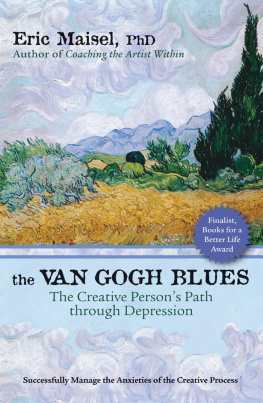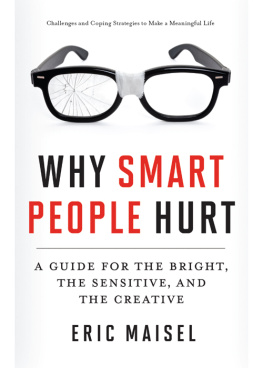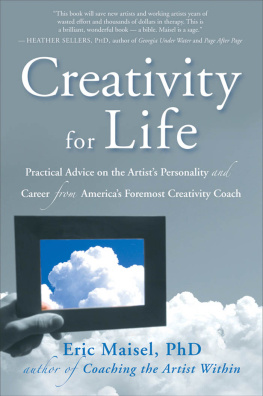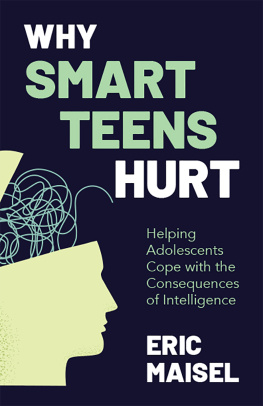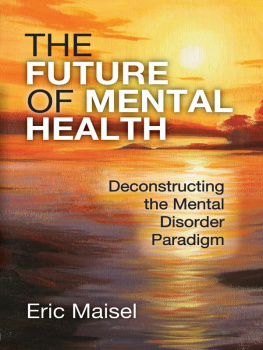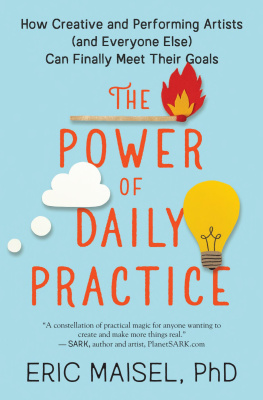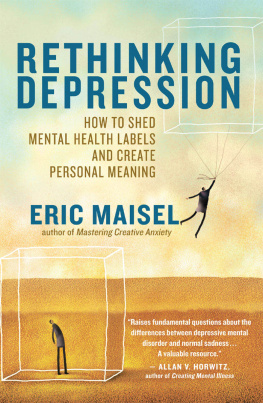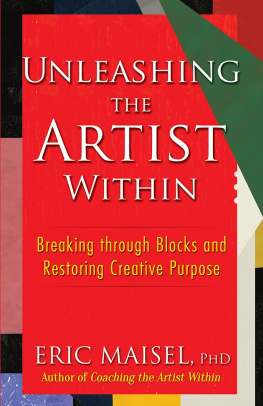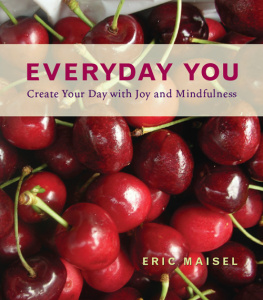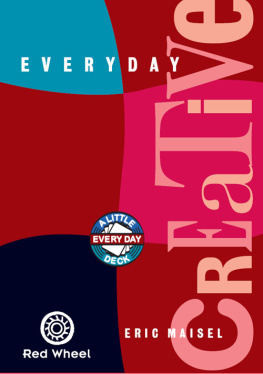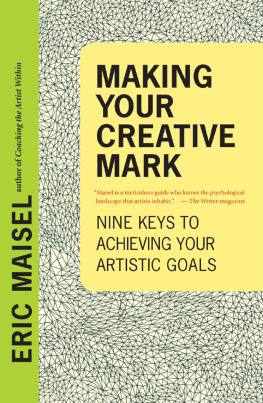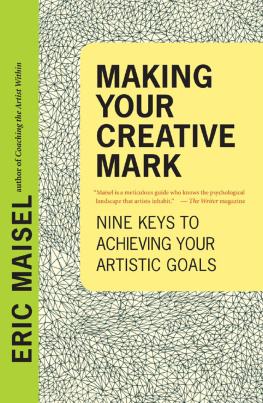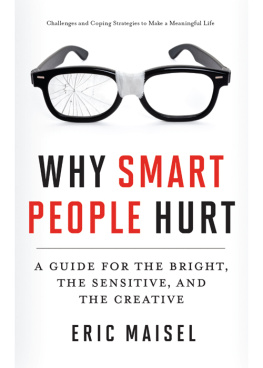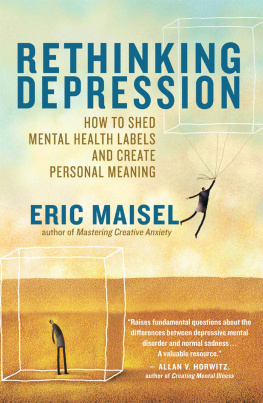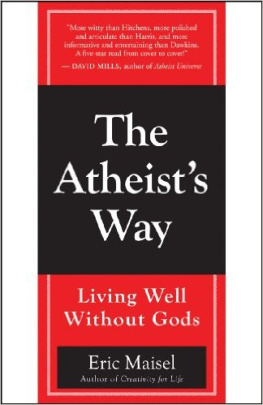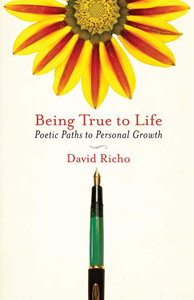
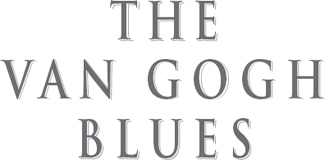


Copyright 2002 by Eric Maisel
All rights reserved. This book may not be reproduced in whole or in part, stored in a retrieval system, or transmitted in any form or by any meanselectronic, mechanical, or otherwithout written permission from the publisher, except by a reviewer, who may quote brief passages in a review.
First New World Library edition, 2008
Originally published in hardcover by Rodale in 2002
Interior designer: Christopher Rhoads
Library of Congress Cataloging-in-Publication Data
Maisel, Eric.
The Van Gogh blues : the creative persons path through depression / Eric Maisel.
p. cm.
Originally published: Emmaus, Pa. : Rodale, c2002.
Includes bibliographical references (p. 239) and index.
ISBN 978-1-57731-604-6 (pbk. : alk. paper)
1. Depression, Mental. 2. Personality and creative ability. 3. ArtistsMental health. 4. ArtistsPsychology. I. Title.
RC537.M335 2008
First paperback edition, January 2008
ISBN: 978-1-57731-604-6
Printed in Canada on 100% postconsumer-waste recycled paper

10 9 8 7 6 5 4 3 2 1
Notice
This book is intended as a reference volume only, not as a medical manual. The information given here is designed to help you make informed decisions about your health. It is not intended as a substitute for any treatment that may have been prescribed by your doctor. If you suspect that you have a medical problem, we urge you to seek competent medical help.
Mention of specific companies, organizations, or authorities in this book does not imply endorsement by the publisher, nor does mention of specific companies, organizations, or authorities in the book imply that they endorse the book.
For Ann, my true partner

CONTENTS
3 MEANINGFUL LIFE, MEANINGFUL WORK,
MEANINGFUL DAYS

I began writing my first novel in 1971, when I was 24, after I graduated from the University of Oregon with an undergraduate degree in philosophy. For the next decade, I lived the novelists life, smoking two-and-a-half packs of cigarettes a day, and frequented coffeehouses and pubs in Dublin, London, Paris, Budapest, Greenwich Village, San Francisco, and other existential locales. I ghostwrote books on every oddball subject from scientific nonfiction to medical thrillers and mysteries, earned a masters degree in creative writing from San Francisco State University, and wrote many novels, some of which were published by small presses.
Then I settled down. I trained to become a psychotherapist, earning three additional degrees: an undergraduate degree in psychology, a masters in counseling, and a PhD in counseling psychology. I became a nationally certified counselor and a licensed marriage and family therapist and, since I loved them, worked exclusively with creative and performing artists. I also began to write nonfiction in the area of creativity and have had a dozen books on that subject published since 1990.
Imperceptibly, the work I was doing began to shift away from traditional psychotherapy and toward a branch of helping I began to call creativity coaching. I found myself uninterested in diagnosing supposed mental illnesses according to prescribed formulae. What engrossed me was working with a creators totality, everything from her anxieties to her marketing skills, her blues to her creative processes. Still in its infancy, creativity coaching is a field I have helped to invent and shape and one that right now is more dream than reality. Few trained creativity coaches yet exist. In recent years, I have begun training new creativity coaches, and we shall see if this helping profession sets roots and becomes a full-fledged career option.
In the early 1980s, I became interested in Vincent van Gogh: van Gogh the painter, van Gogh the individual, van Gogh the icon of the tortured artist, and van Gogh the representative of universal themes in the lives of creators. I gave my first presentation on van Gogh at the 1987 Creativity and Madness Conference in Aspen, Colorado, in a talk entitled Loving Blue: Meaning in Van Goghs Firmament. I accompanied my talk with slides of van Goghs landscape paintings to remind the audience that painted blue skiesmere pigment on canvascould cry out with meaning. From those days until today, I have been chewing on the ideas presented in this book.
Here, I am drawing on many sources: my work as a psychotherapist and creativity coach; information presented to me by readers of my monthly creativity newsletter (read by some thousands); reports from the creativity coaches I train; conversations with friends and acquaintances in the arts, sciences, and business; feedback from conference and workshop participants; my reading of the psychology, creativity, and existential literature; and, of course, from my life in the arts. It may not always be clear whether I am talking about a client in therapy, a creativity coaching client, an artist of my acquaintance, a newsletter reader, or a creativity coach Ive trained, but I hope that any confusion is minimal.
This is not a book about van Gogh. He appears, disappears, reappears, but he never settles down as our central subject or object. Rather, this is a book about all creators: about you, me, painters in Tokyo, biologists in Moscow, novelists in Egypt. It is about who we are, what we do, and why we get depressed. Obliquely, it is about the meaning in literal blue skies and in the blue skies of paintings. Directly, it is about the heroism required of creators. I hope this book will help you and support you when meaning starts to fail and depression stealthily creeps in.


I imagine that you are a creative person or a would-be creative person who has experienced bouts of depression in the past, who may be depressed right now, or who knows that you have the seeds of depression growing in you. You may have tried psychotherapy or antidepressant drugs, but you probably remain unconvinced that the answers you are looking for about the causes and management of your depression can be supplied by psychologists or medical doctors alone. If you are in this situation, this book is for you.
In this book, I provide what I believe is a new, more accurate picture of why creative individuals are prone to depression and describe a plan for managing creators depression. This plan is comprised of several core tasks that you can immediately implement in your life. Even if you avail yourself of therapy, antidepressant drugs, support groups, spiritual practices, or other treatments for your depression, you will still need to master the tasks I outline in this book if you are going to deal effectively with your creators depression.
Next page
